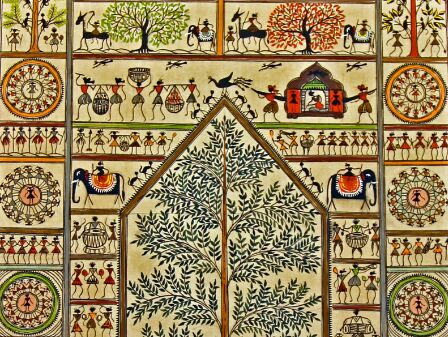Uncapitalised potential
India’s richly decorated tribal arts need promotional efforts to feed the growing demand

Indian history is replete with varied and rich art and culture. Its richness is due to the variety it offers in depicting the varied aspects of nature and human activities. Our civilization and culture have grown in sylvan surroundings which have given rise to a wide variety of art, architecture, dance, music and languages. The vibrance of our culture and spirituality comes not only from mainstream art but also from the variety of tribal arts. The major tribes in India are the Gonds, the Bhils, the Santhals, the Oraons, Khasis, and Garos etc. According to the Anthropological Survey of India, there are 461 tribal communities, out of which 174 are identified as sub-groups. The tribal art depicts tribe-specific rituals and symbols. Some of the important Indian forms of art are Bhil art, Gond art, Saura painting, Madhubani painting, Warli folk painting, Tanjore painting, Pattachitra painting and many others. In this article, the writer would like to describe the evergreen sublime beauty of Gond paintings after he had recently visited some of the skill development centres of Gond art in the Dindori District of Madhya Pradesh.
Gonds are one of the major tribes of India with a history dating back to more than 1,400 years. They are a dominant tribe of Madhya Pradesh but are also found in Andhra Pradesh, Maharashtra, Chhattisgarh and Odisha. The Gond art vividly depicts the varied colours of their life and surrounding nature with uncanny beauty, epitomising the essence of life. One of the best forms of Gond art is the wall paintings seen in most Gond houses. However, it is the canvas painting on clothes and papers that brings them monetary incomes and is slowly catching the eyes of art lovers.
Till about 4-5 decades ago, the Gond art was not known to many people outside their villages but some of the Gond artists like Jangarh Singh Shyam — a Gond farmer in the 1980s — made efforts and gained recognition and fame for the Gond art. He used acrylic on paper and canvas for his paintings and established the 'Jangarh Kalam' school of art. He was the first Gond artist to use acrylic on paper and canvas for his paintings. After his death at the young age of 39, his wife Nankusia Bai has been promoting his work by depicting animals and nature in her paintings. Among others who made the Gond art world-famous was Mayank Shyam whose work became famous after being displayed by Sotheby's — the most trusted marketplace for art, and one of the world's top auction houses in New York. Jangarh's daughter, named Japani Shyam after her Japan visit, is popularising the art through her own style of depicting nature.
Now, the question is whether the Gond art is becoming popular among art lovers across the Indian art markets and whether it has been creating a niche for itself by providing sufficient livelihood opportunities to the young artists to emerge at the national and international scene. To get an answer to this question, this writer visited the Patangarh and adjoining areas of Madhya Pradesh's Dindori district dominated by the Gond tribe. For our assessment, we interacted with several Gond artists and with those who deal with the Gond paintings and visited the skill development centre being run by the state government under the national livelihood mission. We saw the excellent paintings done by the famous as well as new emerging artists on clothes, saris and on paper and discussed with the Block Development Officer and Chief Development Officer of the mission in the Block and the Supervisor of the Centre. In three years, the turnover of the Centre has touched three crore and around 3,000 families are earning their livelihoods. On average, around Rs 6,000-7,000 is earned by one artisan.
This author has visited Australia twice to aboriginal areas and collected Australian paintings from there. The quality of Gond paintings is far superior in vision and beauty than any other painting in the world. Though there are attempts by the individuals as well as government agencies to promote Gond art but, considering the scaling-up needs, these attempts are at best fragmentary and ill-planned to enhance the reach and volume of spread. There is no dearth of art lovers in cities and towns of India. We, therefore, need to evolve a policy to change the tribal and rural development models in the tribal belts and focus on marketing their art and culture. Instead of pumping in a large amount of money into Mahatma Gandhi National Rural Development Programme for land development, the government needs to include tribal art promotion activities like creating a village, block and district-level skill development centres; forging local, national and international market linkages and conduct roadshows in different parts of the nation to reduce unemployment among the tribal youth; and, at the same time, popularise and market the tribal art. At least 25 per cent of the funds in tribal areas should be earmarked for the promotion of tribal art. Let the Ministry of Tribal Affairs and the Madhya Pradesh government start it with the promotion of Gond art.
The writer is Chairman of the Centre for Resource Management and Environment. Views expressed are personal



